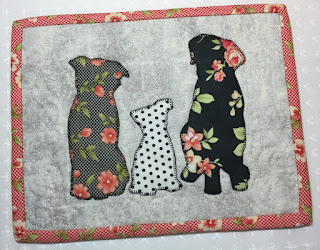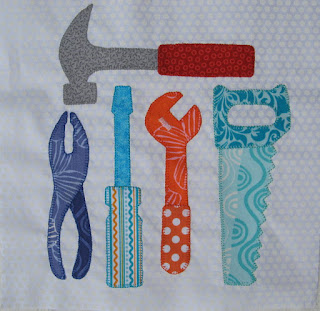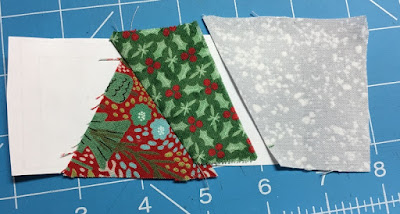I've designed a paper foundation pieced tree for the Christmas Elves wall hanging, so his seems to be good timing for a blog to help those who are wary of this quilting method.
Paper foundation piecing should be neither scary nor curse worthy, yet there are many quilters who would almost rather put away their fabrics and hang up their rotary cutters than quilt on paper. I've been trying to get to the bottom of the problem, and I I'm going to try to help with three of the biggest issues. I won't even attempt to discuss everything, but I'll go over some basic tricks that I hope will be of help to some.
1. There is so much wasted fabric. Quilters hate to waste valuable fabric. No matter how clever we are, there will probably be some waste with paper piecing. It doesn't have to be a huge amount, though. The waste can be controlled with careful cutting of the pieces of fabric.
2. I don't know how to cut the shapes to fit. This issue is actually the same as the wasted fabric concern, and it's easily resolved.
Solution:
Cut fabric pieces the right size and shape.
When I started out with paper piecing, I just guessed and cut out chunks of fabric, hoping they'd fit. That didn't always work, so I slowed down and added a step.
Start with two copies of the paper piecing pattern. Set one aside for sewing on, and cut out all of the numbered shapes on the second copy.
Lay each of the shape cutouts on the wrong side of the fabric you plan to use for that particular piece. You could use a fabric marker to trace around the shape right onto the back of the fabric or not. Cut around each shape leaving a seam allowance of about 3/8". You can
use a ruler and rotary cutter to get the sizing exact, or you can
estimate.
 |
| I'm more of a "wing it" cutter for this, so these are not perfectly cut. I can see already that shape 2 and shape 3 are going to be a bit larger than I needed them to be, so I'm wasting more fabric than i should. | |
|
3. It's just so confusing. Nothing ever fits right. Constantly
ripping seams and trying again with a fresh piece of fabric, over and
over, gets terribly frustrating. This issue is harder to fix because the
ways in which our brains visualize things are as individually unique as
our personalities. I do have an idea or two that might be helpful for
some who get confused by the whole mirror image placement of fabrics and
sewing everything backwards through a piece of paper.
Solution:
Lay the first piece on the back of the paper, right side facing up. I like to use a tiny dab from a glue stick to secure piece #1 in place so it doesn't slide around. A pin would work as well.
Next, lay the second piece right beside the first with the seams more or less lined up. On the pattern in the pictures above, piece #2 is to the left of piece #1, but on the back of the paper we're looking at the right sides of the fabrics, so that arrangement is reversed.
Flip piece #2 over onto the right side of piece #1. Line up the seams.
Turn the paper over and hold it up to a light source. Make sure that piece #2 overlaps the stitching line by about 1/4".
Sew right on on the line.
Flip piece #2 back and check with a light source to make sure it covers the whole shape nicely.
Trim the seam back to about 1/4".
 |
| I estimated and cut the seam with a scissors, but if you are a perfectionist, you could fold the paper back out of the way and trim it with a ruler and a rotary cutter. Just be careful that you don't cut the paper in the process. Been there. Done that. |
Open the new piece, and press the seam.
Piece # 3 will be added in the very same manner. It helps to look at the fabric section and how it fits in the pattern before placing it.
You might even want to slip the piece under the paper to see how it will fit.
Turn the pattern and the new piece over. Line up the seams.
Flip this new piece so the fabrics are right sides together and align the seams as before.
Use a light source to check the alignment from the front. Slide the new piece of fabric so it's about 1/4" from the stitching line. Sew in place, open, check that the fabric covers the space, trim the seam, and press.
When all of the pieces are stitched and pressed, use your ruler and rotary cutter to trim the section exactly on the 1/4" cutting line.
 |
| Trimmed and finished from the back. |
 |
| Front view of this section. |
When all of the sections have been prepared, you can sew them together according to the pattern instructions. Depending on the pattern, I may leave the paper in place and sew the sections through the paper. Other times, I may remove the paper and then sew the sections together like any other piece of patchwork.
I would really appreciate feedback on this tutorial. I'd like to know if this is at all helpful and if you have any ideas about what I can do to improve or change my explanations.
If this still leaves you cold, don't fret. Next week I'll share another option for making a tree that doesn't involve paper piecing.
Have a super week!



















































































